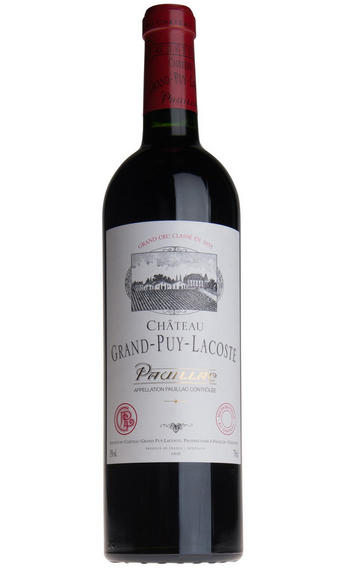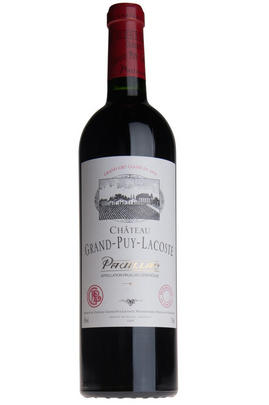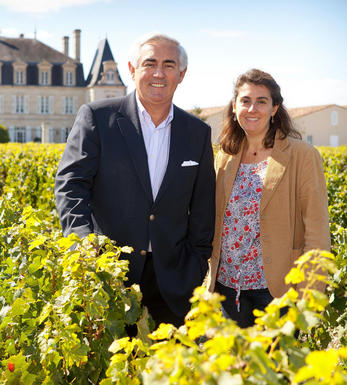
2008 Château Grand-Puy-Lacoste, Pauillac, Bordeaux

Critics reviews
The 2008 Grand Puy Lacoste has a very expressive bouquet with blackberry, cedar and graphite notes, quintessentially Pauillac, building in intensity all the time in the glass but remaining "correct". The palate is medium-bodied with supple tannin on the entry, more red fruit here than black, and good density with a fine bead of acidity. This all leads to a cohesive finish that might be more forward than I expected or would have liked. It is a fine GPL albeit one that feels conservative and does not reach for the stars like other vintages under Xavier Borie.
Drink 2019 - 2033
Neal Martin, Vinous.com (February 2018)
69% Cabernet Sauvignon, 28% Merlot and 3% Cabernet Franc.
Medium-deep red. Inviting, deep aromas of blackcurrant and ripe plum, with a hint of liquorice. Very appealing sweet black and red fruit flavours on the palate; shows a stiffer tannic spine than Haut Batailley from the same owner, but the tannins are also smoother and riper. Finishes pleasantly long, with an obvious cinnamon touch and very good balance. Another wine that may have been more successful in '08 than in either '06 or '07.
Ian D'Agata, Vinous.com (May 2009)
You start to feel the dial turning up the power as this travels through the palate. Even at 10 years old, the tannins go in deep around the fruit, with luscious menthol notes on the finish. This is one of the juiciest of the Pauillacs, with layers of plum fruits, tobacco and melted tannins. It's totally firing on all cylinders, although not a blockbuster, reflective of this vintage. But that means you can drink this now, or you can wait; either way you can enjoy what is going on here.
Drink 2018 - 2034
Jane Anson, Decanter.com (January 2018)
Particularly horsey aroma, which suggests brett influence. This will be divisive according to your preferences, but I think the flavours work quite well in context – it isn't all animal, and there is lots of fruit on offer too.
Drink 2016 - 2034
Jancis Robinson MW, JancisRobinson.com (February 2018)
Not a blockbuster such as the 2005 or 2000, the 2008 Grand Puy Lacoste is an elegant, deep ruby/purple-tinged, pretty Pauillac offering plenty of red and black currant fruit interwoven with touches of spice box and tobacco leaf characteristics. Fresh acidity, medium body, and a pleasant, long finish with excellent depth as well as ripeness suggest it will be a delicate, finesse-styled offering to enjoy over the next 10-15 years.
Robert M. Parker, Jr., Wine Advocate (May 2011)
A beautiful, classic wine, the 2008 Château Grand-Puy-Lacoste has an old-school nose of currants, saddle leather, ground herbs, cherries, hints of dried flowers and just a touch of cedar. It's ripe, medium-bodied, lightly textured, and has true Pauillac character. Drink it over the coming decade or more.
Drink 2019 - 2029
Jeb Dunnuck, JebDunnuck.com (February 2019)
Full red-ruby. Brooding aromas of medicinal blackcurrant, plum, menthol, spices and cocoa powder. Lush and fine-grained but youthfully closed, offering moderate sweetness today but noteworthy breadth for the vintage. Finishes with a fine dusting of tannins and very good length.
Stephen Tanzer, Vinous.com (July 2011)
About this WINE

Chateau Grand-Puy-Lacoste
Château Grand-Puy-Lacoste is a 5ème Cru Classé Pauillac estate which has for many years been consistently outperforming its classification. Grand-Puy-Lacoste is located a couple of kilometres west of the town of Pauillac and is owned and run by François-Xavier Borie.
Grand-Puy-Lacoste's 90 hectares of vines (Cabernet Sauvignon 75%, Merlot 25%) are in one block surrounding the substantial 19th century château and lie on deep gravel beds over limestone. The grapes are fermented in temperature-controlled stainless steel vats and the wine is then matured in oak barriques (50% new) for 18 months.
Grand-Puy-Lacoste combines marvellous cigar box perfume with rich blackcurrant and cassis fruit and velvety power which is the epitome of top class Pauillac at its very best.

Pauillac
Pauillac is the aristocrat of the Médoc boasting boasting 75 percent of the region’s First Growths and with Grand Cru Classés representing 84 percent of Pauillac's production.
For a small town, surrounded by so many familiar and regal names, Pauillac imparts a slightly seedy impression. There are no grand hotels or restaurants – with the honourable exception of the establishments owned by Jean-Michel Cazes – rather a small port and yacht harbour, and a dominant petrochemical plant.
Yet outside the town, , there is arguably the greatest concentration of fabulous vineyards throughout all Bordeaux, including three of the five First Growths. Bordering St Estèphe to the north and St Julien to the south, Pauillac has fine, deep gravel soils with important iron and marl deposits, and a subtle, softly-rolling landscape, cut by a series of small streams running into the Gironde. The vineyards are located on two gravel-rich plateaux, one to the northwest of the town of Pauillac and the other to the south, with the vines reaching a greater depth than anywhere else in the Médoc.
Pauillac's first growths each have their own unique characteristics; Lafite Rothschild, tucked in the northern part of Pauillac on the St Estèphe border, produces Pauillac's most aromatically complex and subtly-flavoured wine. Mouton Rothschild's vineyards lie on a well-drained gravel ridge and - with its high percentage of Cabernet Sauvignon - can produce (in its best years) Pauillac's most decadently rich, fleshy and exotic wine.
Latour, arguably Bordeaux's most consistent First Growth, is located in southern Pauillac next to St Julien. Its soil is gravel-rich with superb drainage, and Latour's vines penetrate as far as five metres into the soil. It produces perhaps the most long-lived wines of the Médoc.
Recommended Châteaux
Ch. Lafite-Rothschild, Ch. Latour, Ch. Mouton-Rothschild, Ch. Pichon-Longueville Baron, Ch. Pichon Longueville Comtesse de Lalande, Ch. Lynch-Bages, Ch. Grand-Puy-Lacoste, Ch, Pontet-Canet, Les Forts de Latour, Ch. Haut-Batailley, Ch. Batailley, Ch. Haut-Bages Libéral.

Cabernet Sauvignon Blend
Cabernet Sauvignon lends itself particularly well in blends with Merlot. This is actually the archetypal Bordeaux blend, though in different proportions in the sub-regions and sometimes topped up with Cabernet Franc, Malbec, and Petit Verdot.
In the Médoc and Graves the percentage of Cabernet Sauvignon in the blend can range from 95% (Mouton-Rothschild) to as low as 40%. It is particularly suited to the dry, warm, free- draining, gravel-rich soils and is responsible for the redolent cassis characteristics as well as the depth of colour, tannic structure and pronounced acidity of Médoc wines. However 100% Cabernet Sauvignon wines can be slightly hollow-tasting in the middle palate and Merlot with its generous, fleshy fruit flavours acts as a perfect foil by filling in this cavity.
In St-Emilion and Pomerol, the blends are Merlot dominated as Cabernet Sauvignon can struggle to ripen there - when it is included, it adds structure and body to the wine. Sassicaia is the most famous Bordeaux blend in Italy and has spawned many imitations, whereby the blend is now firmly established in the New World and particularly in California and Australia.


Buying options
Add to wishlist
Description
The 2008 Grand Puy Lacoste has a very expressive bouquet with blackberry, cedar and graphite notes, quintessentially Pauillac, building in intensity all the time in the glass but remaining "correct". The palate is medium-bodied with supple tannin on the entry, more red fruit here than black, and good density with a fine bead of acidity. This all leads to a cohesive finish that might be more forward than I expected or would have liked. It is a fine GPL albeit one that feels conservative and does not reach for the stars like other vintages under Xavier Borie.
Drink 2019 - 2033
Neal Martin, Vinous.com (February 2018)
wine at a glance
Delivery and quality guarantee